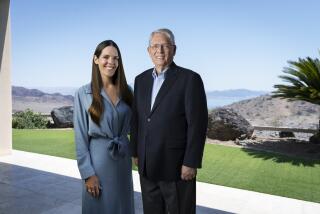Learning to Accept the Inevitable : Health: Many doctors have been slow to refer the terminally ill to hospice care. But now, more are training as specialists who treat pain and help prepare patients for death.
Dr. Christine Nelson wanted to be a cancer specialist, so after medical school and a hospital residency, she went on to a three-year oncology fellowship at Yale-New Haven Hospital.
Nelson soon found herself giving aggressive chemotherapy and radiation treatments to patients whose cancers were incurable. And, she began to wonder if she was doing more harm than good.
“My feeling was I pumped poisons into people, people who were more than willing to take it, even though the treatment doesn’t work very often,” says Nelson.
She was comfortable, however, with the work she did at the nearby Connecticut Hospice. There, she provided palliative care to terminally ill patients who had accepted that their disease had no cure, and helped them with the physical and emotional pain of dying.
“It was probably the only time during my fellowship that I really felt I was doing anything for patients,” she says.
The experience led Nelson to an unusual career decision--to train two more years in the Cleveland Clinic’s palliative care program.
The goal of palliative care is not to cure. Instead, it is to control the symptoms of an incurable disease--pain, nausea, weakness, weight loss--and help the patient deal with social, psychological and spiritual needs.
In the United States, palliative care has been primarily limited to hospices. But interest in the field is growing, and advocates predict that, within the next 10 years, it will become a mainstream medical specialty with professorships, postgraduate training programs and departments in major medical centers.
Today, the only postgraduate programs are at the Cleveland Clinic and the M.D. Anderson Cancer Center in Houston, which started training its first doctor this summer in association with The Hospice at the Texas Medical Center.
Oncologist Declan Walsh, director of the 3-year-old Cleveland program, says palliative care has been given short shrift for too long:
“Five-hundred thousand people die of cancer every year in the United States and what’s being done to look after them? To improve their care? The answer is, very little.
“The National Cancer Institute and the American Cancer Society spend next to nothing on non-curative cancer treatment. They are interested in prevention; they are interested in curative treatment, surgery or chemotherapy. But they spend very little money on pain control or psychosocial issues.”
One reason for neglect of palliative care, he says, is this country’s dedication to a high-tech pursuit of a cure, even though most leading cancer killers--of the breast, colon, stomach, pancreas and lung--remain incurable once they have spread.
“Doctors have painted themselves into a corner promising cancer cures,” says Walsh. “After 30 years, the evidence is that in most Western countries, the mortality and maybe the incidence of cancer is on the rise.”
As a result of America’s war on cancer, a national standard of care has emerged that may not be in the patient’s best interest, he says:
“Consider (the late) Michael Landon’s case. (He) gets pancreatic cancer with liver metastases. What is the standard of care in that situation? Well, in the United States the standard of care is to give him some form of chemotherapy even though everyone knows all those patients are usually dead within a few months.
“I am unaware of any study that demonstrates that chemotherapy in that context significantly improves the quality of life or indeed the duration of life to anything that would appear worthwhile.”
The tragedy of this ethic, says Walsh, is that it causes many doctors to offer, and patients to accept, aggressive treatment when their time might be better spent in palliative care.
If patients were to receive such care early on, before they become so sick, the transition to a hospice setting in their last months would be smoother, he says.
“Most medical centers that see a significant number of cancer patients and other serious diseases should have these services, because these patients are falling through the cracks and no one is actually looking after them in any meaningful sense,” Walsh says.
The U.S. medical Establishment, however, has been slow to accept palliative care.
Unlike those in Canada and England, U.S. hospice programs started outside of hospitals, as part of a grass-roots movement. As a result, few hospital-based doctors have daily contact with such programs, and medical students receive little exposure to palliative care practitioners.
Only about 30% of the nation’s 1,700-plus hospice programs are in hospitals. Most others either contract with hospitals or accept referrals from them. Patient care is typically supervised by either staff or personal physicians.
Although more than 180,000 people died last year in hospices, few physicians referred their patients to palliative care specialists, says Dr. Porter Storey of The Hospice at the Texas Medical Center.
“We get consultations, but not from private oncologists. We get them from family members or the patient’s next-door neighbor who had used us for their relative or from the pastor.”
He believes some doctors resist palliative care because they are reluctant to give up paying patients.
“But I think the two biggest issues are ignorance about what we offer and the fear of dying--the fear of talking about dying,” Storey says.
“You know, it’s just easier for an oncologist to say, ‘Come back and see me next month’ when he knows the patient will be bed-bound and too weak to be able to, instead of saying, ‘Gosh, you’re getting really weak. We know your cancer is progressing. How about we get you into a hospice service because you are going to die from this soon.’ That’s a tough message.”
This situation may soon change as oncologists become increasingly aware that more must be done to address the palliative care needs of their patients, says Dr. Stuart A. Grossman of the American Society of Clinical Oncology.
Grossman is chairman of the ASCO committee on cancer pain, whose formation is to be announced today. The new panel will make recommendations to the society’s board this November.
“There has been too much emphasis on treatment and not enough on palliative care,” he says. “We need to learn to pay more attention to the little things that mean a great deal to the patient.”
Potential patients are much more receptive to the service, says Dr. Martin Skinner, president of the Academy of Hospice Physicians: “Our surveys show that more and more people are willing to say, ‘Doc just keep me comfortable, I don’t want another round of chemotherapy.’ ”
He says the growing interest in euthanasia, which he opposes, is partly a result of doctors’ failure to address the needs of the terminally ill. If more hospitals and clinics adopted palliative care programs to address pain and other symptoms, the fear of dying and the appeal of euthanasia would lessen, Skinner says.
Greater awareness and funding will help researchers develop new treatments that palliative care programs could disseminate to all physicians, he says.
“These techniques and medicines are not unique to hospice care, but hospice physicians may have learned how to use them a little more effectively,” he says.
Palliative care specialists in hospitals and clinics may also help moderate aggressive treatment that dominates American medicine, says Dr. Michael Levy of the Fox Chase Cancer Center in Philadelphia.
“The importance of sub-specialty training is that it provides a role model. It allows you to see what someone else can do, to see that it’s OK to stop giving chemo, that it’s OK to say, ‘I think this will cause you more harm than good, and let’s just try to make your final time as good as it’s going to be,’ ” Levy says.
When Dr. Elizabeth Strauch, the first to train in palliative care at M.D. Anderson Cancer Center, entered medical school, she thought she would become a plastic surgeon.
But by the end of her residency, she had decided to go into palliative care, even though most of her teachers tried to dissuade her.
“They’d say, ‘Oh, you’re much too smart, much too creative, too talented. It’s so hopeless; you’ll burn out,’ ” Strauch says.
Instead, she finds tremendously rewarding--and difficult--to help terminally ill patients in the few weeks or months they have left.
“It was my concept of what a real doctor was about: sitting at the bedside, listening to the patient, and making them feel better. That’s gotten lost in the aggressive treatments, the high tech, the big business,” she says.
“It’s one of the last bastions remaining of old-time medicine--gentle, contemplative, and caring.”






